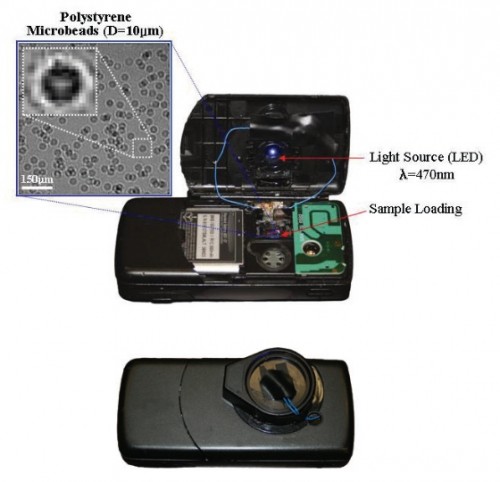The access to health care in many countries is scarce. And with this obstacle comes fewer health checks which weaken the ability of improving overall health within a country. But I believe a possible solution is realistic with the combined force of Ushahidi tools and one of University of California Los Angeles (UCLA) latest research advancements. UCLA has designed a mobile phone which essential brings the hospital to an individual.
Lensless Ultra Wide Field Cell (LUCAS) uses shadow imaging to capture an image of each cell in an entire sample, while detecting volume in less than a second.
[caption id="attachment_580" align="alignright" width="500" caption="LUCAS Prototype via UCLA Newsroom "] [/caption]
This lens free method accurately counts targeted cell types in a single cell solution. LUCAS' size is what makes it easy to integrate into any ordinary cell phone. And biology is what makes shadow imaging reliable. Each various cell has its own shadow patterns therefore allowing computers to identify red blood cells, fibroblasts etc. using algorithms.
With Ushahidi, cell phone data could be sent and organized within one central location. Allowing for easy detection of epidemics and allowing international health organizations to respond rapidly. In reality, a partnership between Ushahidi, LUCAS and cell phone companies would allow improvement in health in many countries to become a more attainable goal by improving efficiency and cutting on time.
[/caption]
This lens free method accurately counts targeted cell types in a single cell solution. LUCAS' size is what makes it easy to integrate into any ordinary cell phone. And biology is what makes shadow imaging reliable. Each various cell has its own shadow patterns therefore allowing computers to identify red blood cells, fibroblasts etc. using algorithms.
With Ushahidi, cell phone data could be sent and organized within one central location. Allowing for easy detection of epidemics and allowing international health organizations to respond rapidly. In reality, a partnership between Ushahidi, LUCAS and cell phone companies would allow improvement in health in many countries to become a more attainable goal by improving efficiency and cutting on time.
 [/caption]
This lens free method accurately counts targeted cell types in a single cell solution. LUCAS' size is what makes it easy to integrate into any ordinary cell phone. And biology is what makes shadow imaging reliable. Each various cell has its own shadow patterns therefore allowing computers to identify red blood cells, fibroblasts etc. using algorithms.
With Ushahidi, cell phone data could be sent and organized within one central location. Allowing for easy detection of epidemics and allowing international health organizations to respond rapidly. In reality, a partnership between Ushahidi, LUCAS and cell phone companies would allow improvement in health in many countries to become a more attainable goal by improving efficiency and cutting on time.
[/caption]
This lens free method accurately counts targeted cell types in a single cell solution. LUCAS' size is what makes it easy to integrate into any ordinary cell phone. And biology is what makes shadow imaging reliable. Each various cell has its own shadow patterns therefore allowing computers to identify red blood cells, fibroblasts etc. using algorithms.
With Ushahidi, cell phone data could be sent and organized within one central location. Allowing for easy detection of epidemics and allowing international health organizations to respond rapidly. In reality, a partnership between Ushahidi, LUCAS and cell phone companies would allow improvement in health in many countries to become a more attainable goal by improving efficiency and cutting on time.